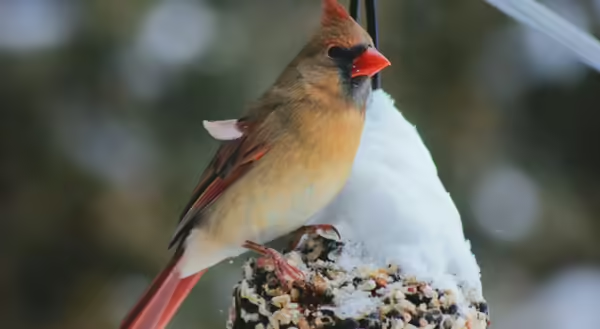
Creating simple, homemade birdfeeders is a great way to support feathered friends during the cold winter months when food sources are scarce. It also allows us to be creative, resourceful, and engage with nature while stuck indoors. Make your backyard more wildlife-friendly by making a few of these natural, DIY birdfeeders.
Citrus Feeder
Select any citrus fruit to create this feeder. My favorite is grapefruit because they are large and smell delicious. Cut the fruit in half and scoop out the insides so you are left with a bowl (and enjoy the fresh treat!). Poke three holes through the peel evenly spaced around the orange, ½ inch down from the rim. Thread string through the holes, tying knots on the outside of the citrus to hold it in place, and then tie all the string ends together to create a hanger. Fill the citrus bowl with birdseed.
Pinecone feeder
Gather a pinecone, peanut butter or vegetable shortening, birdseed, and string to create this natural feeder. Attach the string to the pinecone to hang from a branch. Cover the pinecone in peanut butter or vegetable shortening, getting between the cracks and crevices of the cone. Next roll the covered pinecone in the birdseed, slightly pushing down so the seeds stick, covering it completely with seed.
Cranberry-popcorn garland
Practice your sewing skills creating this feeder! Collect thread and needle, a bag of popcorn, and some fresh cranberries. Thread the fruit and popcorn onto the string, creating a pattern of your choice. Tie a knot in the string when you get the desired length, then use the garland to add décor to an evergreen tree in the landscape. If you want to create a wreath, simply use florist wire and twist the ends together to form a circle. You can also add other grains, cereal, fresh or dried fruit, or nuts to the mix!
What kind of birdseed should you use when creating your DIY feeders? Different birds have different preferences on the type depending on their beak and nutritional needs. The most popular among backyard birds is sunflower seeds. Birdseed mixes can also be used, but remember that higher-quality mixes will attract more diverse birds and will provide better nutrition and healthier birds.
When hanging your homemade birdfeeders, you also want to make sure you hang it away from other birdfeeders to prevent overcrowding and the spread of disease. Discard your feeder after the seeds are gone or if they become spoiled.
When making these feeders with children, talk about different foods that different birds eat and how bird species have beaks adapted to eating certain types of food. Create a journal to track what kind of birds visit your feeders and when you first see them.
Enjoy feeding and watching our feathered friends this winter!